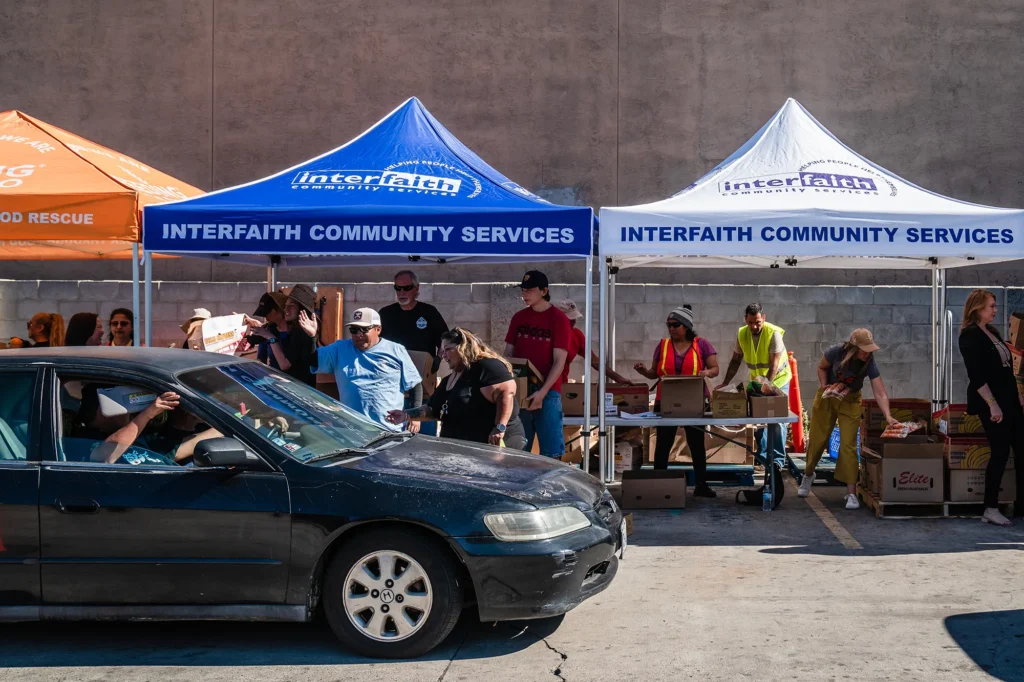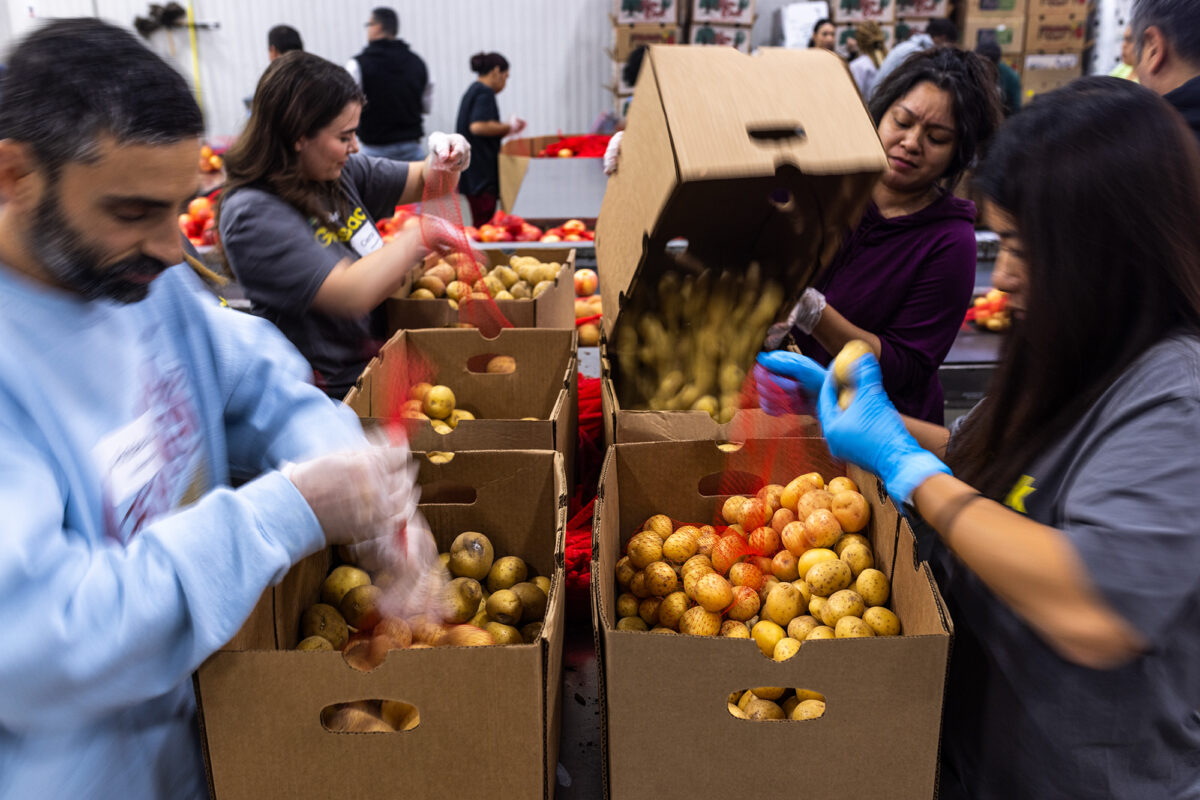Each Thursday, food pantry workers in the city of Bellflower sort through breads, fresh produce and canned goods. Early risers line up with their bags, cardboard boxes and carts outside St. Dominic Savio Catholic Church, ready for distribution at 8 a.m.
For some, that routine became more urgent this week. Five-and-a-half million low-income Californians are enrolled in CalFresh, the state’s version of the federal Supplemental Nutrition Assistance Program. The program was formerly known as food stamps, and now functions through debit cards.
With the federal government shut down and the Trump administration refusing to tap funds to keep food assistance on schedule, refrigerators are emptying, cupboards are running bare and fears are rising.
“Without these food banks providing, I don’t know what we’re going to do,” said Miriam Hernandez, a Paramount resident who rushed to St. Dominic’s after dropping her children at school.
Around the state, food pantries expect demand for goods to surge over the next several weeks. To help meet the need, California, county agencies and private groups are pouring in tens of millions of dollars in backfill funding. California Attorney General Rob Bonta this week joined other states in suing the federal government, seeking to restore federal financial support for SNAP programs, including CalFresh. In a separate case, a federal district court judge in Rhode Island has ruled that the U.S. Department of Agriculture must use emergency funds to keep food aid flowing, though how quickly the department will respond is unclear.
For about 3.5 million senior citizens and children who use CalFresh, food planning has already changed.
Waiting in line, tote in hand, Hernandez said she’s been feeling nervous. To prepare for delays in receiving CalFresh benefits, she’s stopped by multiple food pantries in Los Angeles County, grateful for anything she can get her hands on.
Hernandez has six children, four of whom are still in school. Her husband is the main breadwinner, and with the rising price of groceries, she said CalFresh has been a huge help in her household — it’s largely how she buys meat and poultry. She is hopeful benefits will return soon, but in the meantime, she’ll have to make do with what she can find at pantries. Items like rice, lentils and beans can go a long way, she said.
“Moms, we work it out with the little that we have, and we try to make a meal no matter how little it is,” she said.
California, counties intervene
California has released $80 million to support food banks across the state. Gov. Gavin Newsom has also sent the California National Guard to help food banks pack and distribute food.
Bonta joined National Guards and volunteers packing bell peppers and potatoes at the Los Angeles Regional Food Bank to make a point on Thursday. While the U.S. Department of Agriculture says it lacks funding to provide SNAP benefits to 40 million Americans, Bonta said the federal government has more than $5 billion in contingency funds earmarked for the program. A multi-state lawsuit demands that the federal government use those funds to avoid shutting the program down for the first time since it began in 1964.
“Those funds are sitting there unspent and it is unconscionable, it is immoral, it is illegal,” Bonta said.

A federal district court judge in Massachusetts has ruled that the states’ suit is “likely to succeed” and has given USDA until Monday to consider whether the department can continue at least reduced benefits in November. And while a Rhode Island district court has ordered the federal government to continue funding benefits, it’s not clear how soon or whether the Trump Administration will take action.
Even with federal orders to continue aid, Bonta said it could take “about a week” before benefits are available to electronic debit cards.
Counties and local governments are also working to gather resources and aid. In San Francisco, supported in part by a private donor, the city will provide gift cards to CalFresh members to fully cover their November food benefits.
With millions of families across the state and country in limbo, food banks and pantries are becoming a lifeline for many more people.
In North County San Diego Thursday, hundreds of families showed up to Interfaith Community Services in Escondido for an emergency food distribution with a regional partner, Feeding San Diego.
People waited in their vehicles for the drive-through food bank in a snarl of traffic that backed up outside the center. Each family received one or two boxes filled with fresh strawberries, apples and cucumbers, along with peanut butter, bread, canned beans and tuna, and a few treats, such as fruit popsicles and chocolate cake pops.
The organizations expected to serve 250 families, but stretched that to 270. On a normal day the Interfaith food pantry might serve 30 to 40 families.
“Today, people are panicked,” said Carissa Casares, a spokesperson for Feeding San Diego. “They’re thinking, how am I stocking my fridge? How am I filling my pantry?”

At the Los Angeles Regional Food Bank, which partners with organizations across the county to bring pantries to churches, senior centers and schools, several factors have contributed to increased demand this year, said CEO Michael Flood.
In January, historic wildfires devastated Los Angeles communities. “And because those fires were so huge, that ripple effect is still there,” Flood said. Then in October, federal workers who aren’t getting paid because of the shutdown began requesting food boxes. Now with the suspension of CalFresh benefits, that need is likely to surge. About 1.5 million Angelenos rely on food assistance.
His food bank is planning large distribution events for thousands of people similar to those organized during the pandemic. “This is a disaster type of situation for us here in Los Angeles County, throughout the state of California, and throughout the country,” he said.
College students, recent graduates seek stability
Beyond the senior citizens and children who make up the majority of program participants, veterans, people with disabilities and young people are also trying to make ends meet.
About 200,000 college students use the assistance program, and some continue to do so even after they graduate.
A third-year international development student at UCLA, Jade Duarte, said her entire family relies on CalFresh.
“My grandfather just had open-heart surgery,” she said. “He’s dependent on good nutrition to recover, right? So things like this would hinder, essentially, his way of recovery, because they’re cutting his money.”
For her own needs, Duarte seeks support beyond her family’s CalFresh. A food pantry at UCLA offers quick meals like ramen. But demand exceeds what food banks can provide, she said. “It’s not going to be able to take care of the whole situation.”
On college campuses around the state, demand is growing at basic needs centers that serve as resource hubs, connecting students with food assistance and other support programs. At UC Berkeley on Wednesday, the online queue to access free food opened at 1 p.m. It was full by 1:01 p.m. The pantry also opened another time slot on Mondays.

While basic needs centers are meant as a short-term solution, some students return again and again. Temuujin Sarangerel, a second-year Berkeley City College student studying business administration and finance, stops at his school’s center one or twice a week as one of his main sources of food.
He and his mom share a CalFresh debit card, and they will have to cut back on meat and other foods if their benefits don’t come in. The prospect makes him “sad and stressed.”
In Los Angeles County, 22-year-old Dante Thomas, a recent graduate of the University of San Francisco, stopped by St. Dominic’s food pantry for the first time. Living now in South Gate, Thomas said he knows how to stretch CalFresh benefits strategically to last the entire month.
Under the pressure of student debt and keeping up with rent, Thomas said food assistance supports his mental well-being: It’s one less thing to worry about.
“It’s a little demoralizing as a young person,” he said. “Benefits are being cancelled and I can’t find a consistent role in my career, so things are definitely a little hard right now.”
Preparing for the possibility that CalFresh won’t come through starting Saturday Thomas said he has been even more judicious about what he buys. “I’d go to the store and get a salad or something … and now I don’t even think that’s something that makes sense to do financially,” he said. “It’s very hard.”
Supported by the California Health Care Foundation (CHCF), which works to ensure that people have access to the care they need, when they need it, at a price they can afford. Visit www.chcf.org to learn more.
Phoebe Huss and Chrissa Olson are contributors with the College Journalism Network, a collaboration between CalMatters and student journalists from across California. CalMatters higher education coverage is supported by a grant from the College Futures Foundation.

